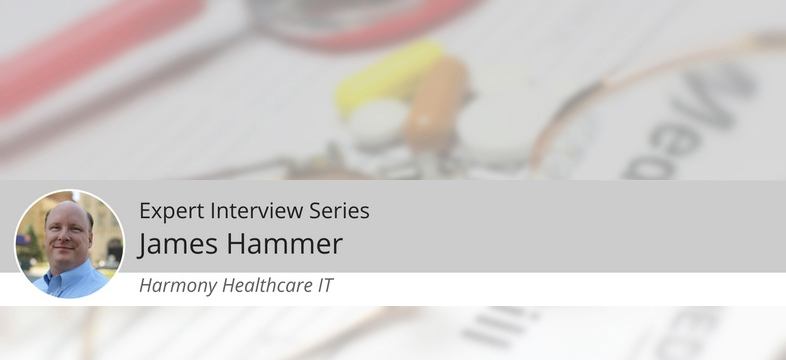
James Hammer is the VP of Product & Program Management at Harmony Healthcare IT, where he leads a team of data migration and archiving experts charged with preserving vital information so lives may be improved.
Here, he discusses how Health IT has evolved and offers his advice to practices that are shopping for EHR solutions. Read on:
Tell us about your professional background and interest in Health IT?
After college, I worked for a large behavioral health clinic and eventually became the business office director. As I encountered challenges with the automation used at the clinic, I became motivated to move into a health IT role so I could influence the development of technology to enable healthcare. For the next decade, I worked in a variety of positions including support, implementation, product management and development. Now, 20 years later, I continue to find challenges and areas to improve patient lives and assist in the reduction of healthcare costs through the use of Health IT.
How has technology changed the healthcare industry since you started your career?
Today is Monday, let’s give it until Wednesday and let’s see the change that happens.
Seriously, when I started it seemed the focus was on the technology itself, not how it could improve the workflows or performance of individuals performing their jobs. Now that workflows have been addressed, we’re moving into patient engagement. What used to be hidden in a paper chart, is now readily available online – real-time health statistics, integration with consumer wearables, communication via a patient portal.
However, I still shake my head in disbelief that healthcare lags so far behind the financial industry. We can make business transactions between disparate banking institutions, but we can’t seem to do the same in healthcare where much of the market still relies heavily on fax technology versus health information exchange (HIE).
What are the most exciting healthcare innovations you’re following right now?
The continued push toward true Interoperability. Our core mission at Harmony Healthcare IT is to improve lives by preserving vital information. Readily accessible historical records can change the course of treatment for a clinician, make an HIM director’s fulfillment of a release of information request more efficient and make eDiscovery in the case of litigation efficient for a lawyer. Further, making historic patient data available through interoperability is top of mind for us. We are focusing a lot on web services, API’s and the new HL7 FHIR standard.
What are the most common challenges or frustrations facing your clients today? How do you help them?
Our customers are, or have already, migrated to a new EHR or ERP system. In doing so, at least one, if not many legacy systems are “left behind.” As data conversions are costly and complex, patient data sits in these out-of-production systems. This adds to the organization’s burden of maintenance, infrastructure and additional personnel required to keep multiple legacy systems alive. We offer services and products to eliminate this burden while meeting state and federal medical record retention requirements.
When should practices consider replacing or updating their EMR systems? What are indicators that a system has outlived its usefulness?
When automated workflows don’t satisfy user or governmentally-mandated requirements, a new EHR should be evaluated. Most often we see system replacement as a result of merger and acquisition.
How should practices approach shopping for EMR systems? What considerations should they make or questions should they ask early on in the process?
There has been a lot of consolidation in the EMR market. A practice should look to the stability and culture of a potential vendor. While difficult to predict, try to choose a vendor that will be around in five years (which is a long time in healthcare IT today). We see a few excellent specialty specific vendors people select, and most others choose between the top three to five industry-leading vendors.
What are the most common mistakes or oversights you see practices making during this process?
Oddly enough, we see quite a few practices base selection decisions on price, and generic demonstrations and verbal phone based reference checks. We urge our customers to go deep; require a like-for-like practice demonstration where they can go on-site with their team and see real workflows in action that are in the same specialty. Press for lessons learned; what did not go well and how did the vendor respond? No implementation goes perfectly, and how the vendor acts as a partner during these road bumps is crucial for a long-term partnership.
What are the most important features of functionality practices should keep an eye out for in their EMR?
The most important feature to look for is if the EMR has been Meaningful Use Certified. After ensuring the vendor meets core requirements in the industry, study workflows and ensure they align with usability demands of your providers and staff. Ask to see product roadmaps. For example, how well does the EMR interoperate with other systems in the market? Do they support CDA/CCD exchange, and what is their alignment with the new HL7 FHIR standard?
What are best practices for transitioning from a legacy system to a new one? What should practices do to prepare their staffs ahead of the roll out?
It is important to define a strong governance team that has input from all areas of the practice or health system. The governance team should weigh such items as the amount of data that will be migrated versus the cost/benefit and duration of the storage. I also recommend insisting to see sample workflows and where data will appear after data is migrated and/or archived within the new EMR.
What’s one piece of advice you find yourself repeating to clients over and over?
Follow best practices. Take advantage of the hard work your peers have already done, and learn from their mistakes.
Shopping for new billing software? Start comparing plans and prices Compare plans and pricing.


